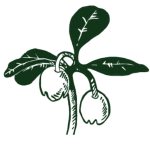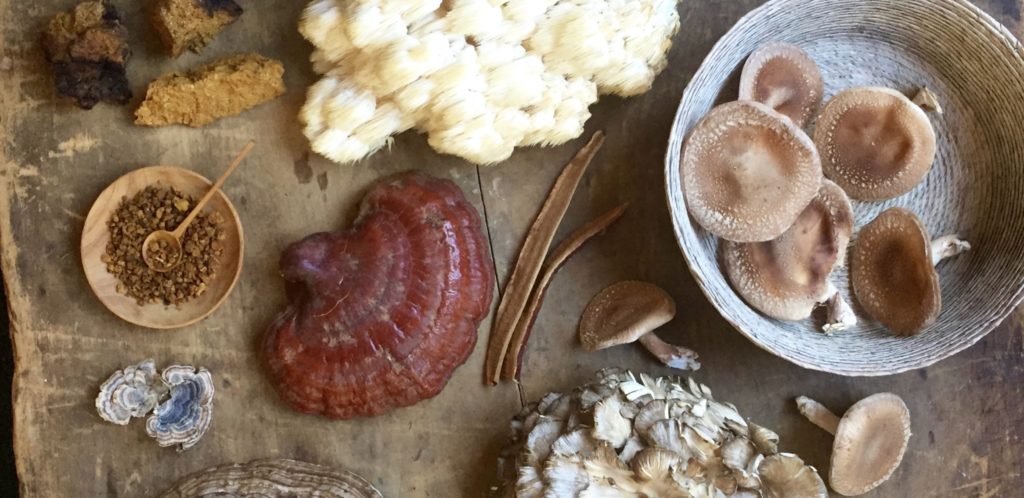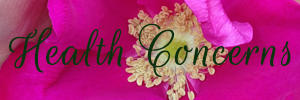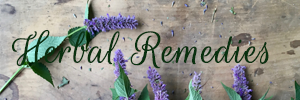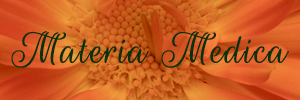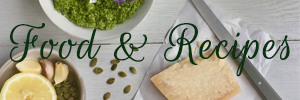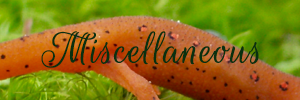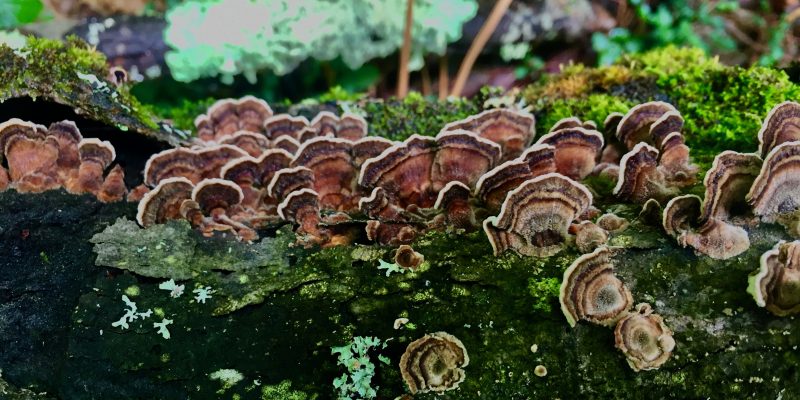
What’s a Mushroom? Fungal Formats
A “mushroom” is defined as a fungal fruiting body growth, often with a dome-shaped cap, usually above ground, sometimes with gills (pores are also common) and a stalk. They are to fungi what flowers are to plants: the reproductive part. Fruiting bodies form when the fungal organism is in peak form in order to release spores (which are much like seeds) that propagate the species. When the spores germinate, they gradually form mycelium. When you pick up a rotting log and see the white, cotton-like threads growing underneath, you’re seeing mycelium in action. This vegetative growth moves through soil and other substrates like woodchips, trees, or logs consuming nutrients. When the time is right, it sprouts a fruiting body and the life cycle continues again.
Fruiting Bodies: Traditionally we work use the fruiting bodies of specific edible and medicinal species. Fruiting bodies contain the aforementioned chitin fiber and generally should be cooked or simmered in order to break down the chitin and make other constituents bioavailable. Many otherwise safe-to-consume edible and medicinal mushrooms can also be mildly toxic (due to bacteria or other compounds) irritating to the digestive system if eaten raw, too. That said, poisonous mushrooms are still deadly no matter how much you cook them.
Mycelium: This vegetative fungal growth has become another popular format for medicine in the United States because it’s easier, cheaper, and faster to grow for market, often on grains like rice or millet. Many of the “mushroom” capsules, powders, and extracts on supplement shelves are made with all or mostly mycelium and will also contain some of the grain or substrate in which it’s grown. There is debate over how potent mycelium is. It’s not exactly the same as a fruiting body in its properties, yet it still offers medicinal value – including beta glucans and terpenes – and can have unique beneficial constituents. Store-bought mycelium powders generally do not need to be cooked and are easier to extract constituents from. Check if companies that guarantee certain levels of particular constituents, like beta glucans, and how much substate (like grain) is included.
Special Extracts: Many companies pre-extract or activate mushrooms and/or mycelium via a variety of methods to make the properties more bioavailable for you. The quality and potency can vary widely, so you’ll want to contact the company to learn more.
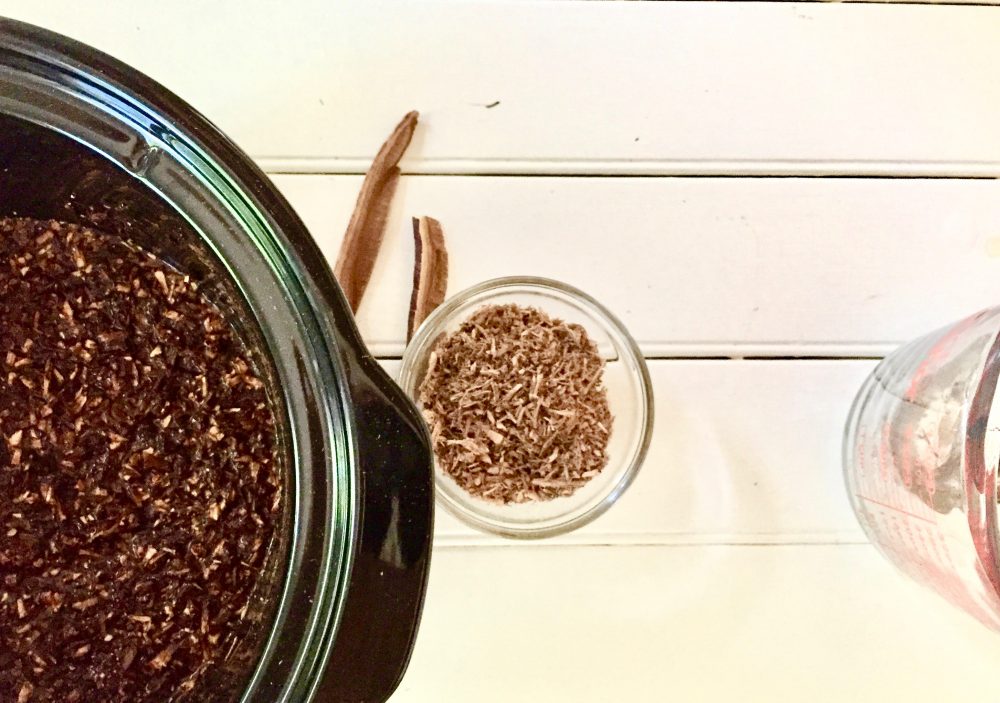
Quick Tips:
Assuming you’re working with regular o’l mushrooms (fruiting bodies)…
- Always cook or simmer your mushrooms thoroughly.
- Powdering dried mushrooms will also help release beta glucans from chitin to be more bioavailable. You can powder them while they’re dry, with water, or rehydrate then puree in a blender. Then continue with your process.
- Hot water extraction, a gentle decoction for tea, broth, etc. (preferably for one hour or longer) is best to extract immune modulatory beneficial polysaccharides like beta glucans.
- Polysaccharides including beta glucans can be destroyed by alcohol, toasting, and high heat
- Beneficial anti-inflammatory terpenes also extract well in tea, as well as alcohol. They can be diminished with high heat.
- Dry toasting may offer some of the benefits of cooking – such as killing bacteria – and improve savory flavor for culinary recipes, but you will likely diminish some of the polysaccharide and terpenes in the process.
- Don’t use mushrooms that are old, gone by, rotten, slimy, smell funny, or that you’re not 100% sure of the identity, etc.
- Freezing whole mushrooms like reishi – whether foraged, cultivated, or store bought – for a few days helps kill larvae.
Cooking with Mushrooms
Tender, tasty, edible mushrooms can easily be sautéed, added to soups, or otherwise cooked thoroughly and eaten. The classic method – which I adore – is to sauté fresh chopped mushrooms in butter and/or olive oil until they’re well cooked, seasoning with salt, pepper, and garlic or garlic powder. Some fresh fried sage leaves in the mix is also delicious. This is delicious as is or can be the start of a stir fry, pilaf, sauce, etc. Favorites include classic culinary mushrooms like button, crimini, portobello, as well as shiitake, lion’s mane, oyster, maitake.
Using Mushroom Powders
Mushroom powders are incredibly versatile and varied. You can make your own by grinding dried mushrooms in a blender. I use a high-powered bullet-style blender. If desired, sift through a fine mesh metal hand strainer to get a finer powder. Mushrooms like shiitake powder well whereas reishi is more insulation-like. Remember – dry powdered raw mushroom fruiting bodies are still best cooked or simmered. But commercial powders may be pre-extracted, mycelium, heat-treated fruiting body, or a combination. Check with the company to find out how it’s been treated and if it needs to be cooked.
Mushroom powders can be added to simmering tea, soup, broth, stir fries, casseroles, and used to make all manner of simmered extracts including double-extraction tinctures, syrups, concentrates/ice cubes, etc. I particularly enjoy using shiitake powder in the kitchen because of its mild flavor. Lion’s mane powder is also tasty. Maitake powder can also be used, but I’m picky and only like the flavor of perfectly fresh maitake.
Concentrated Extract Powder
Christopher Hobbs, herbalist and author of the excellent new book Medicinal Mushrooms: An Essential Guide suggests investing a little up front time for technique to create an extract you can later consume as-is. Basically, you simmer chunks of mushroom in water for several hours (or in a pressure cooker on high for 45 minutes with the “keep warm” function turned off). Let cool, then puree in a blender to a creamy slurry “batter.” Pour onto lightly oiled fruit leather trays and dehydrate at 95 degrees. Once dry, grind the wafers to a powder. You can add this powder to any recipe you like without having to re-cook it. You an make a quick tea by pouring hot water over it, encapsulate the powder, mix it into various recipes (like honey nut butter energy balls), etc. It will be a bit gritty, but it offers a wide range of benefits including fiber and polysaccharides with some terpenes and other constituents. Consider doing this with any mushroom, particularly lion’s mane, shiitake, reishi, or turkey tails.
Basic Decoction (Tea or Broth)
Simmer fresh, dry, chopped/sliced, whole, or powdered mushrooms in water for at least 20 minutes (preferably 1 hour or longer). The strongest decoctions are made with powdered or pureed mushrooms. This make a great tea or broth base. For broth, add bones, garlic, onions, carrots, celery, etc. For tea, herbs for tea if desired during the last 20 minutes. Strain, and enjoy.
- Shiitake Chicken Broth is a household staple. I freeze it in pint jars to grab easily. Other pleasant tasting mushrooms can also be used (lion’s mane, oyster, turkey tail…), but I like shitake’s mild flavor. Jazz it up by adding lemongrass stalks during the last 20 minutes of simmering, and/or add chopped scallions before serving. Vegetarian? Skip the bones – it still tastes good. I wrote a whole article on broth in the Winter 2019 issue and on my blog at wintergreenbotanicals.com/broth.
- Mushroom Chai is another favorite. Astragalus root can be simmered alongside reishi, chaga*, or other mild mushroom. During the last 20 minutes, per pint, add 2 cinnamon sticks, 1 star anise pod, 2 cardamom pods, and 5-7 cloves. Ginger, a pinch of nutmeg, fennel seeds, and/or a pinch of licorice are also nice additions. Other medicinal tonic additions include marshmallow root, codonopsis root, maca root, nettle leaf, or oat straw.
- Mushroom “Coffee” has become quite popular as a substitute for real coffee! Reishi’s bitter flavor can be tricky in some recipes but pairs well with coffee-like flavors. Simmer ground reishi with equal parts roasted chicory root and dandelion root for 20 minutes or longer. Other nice ingredients include burdock root, maca root, ashwagandha root, marshmallow root, cacao nibs, turmeric, and/or cinnamon. Also consider turkey tail, chaga*, or lion’s mane for the mix.
Concentrate
Once again, a little extra work up front makes for an easy-grab day-to-day mushroom remedy! Once you’ve made a large pot of hot water decoction, broth, or tea, strain, then simmer the liquid uncovered until the volume has reduced dramatically. There’s a lot of flexibility in how concentrated you can get, just make sure it doesn’t dry and burn on the pot. I often concentrate 1-2 quarts of tea down to ½ to 1 cup of concentrate. Then proceed as you like…
- Concentrated Ice Cubes: Let the concentrate cool, then freeze in ice cube trays. How you can use the ice cubes to make instant broth or tea (just plunk a cube in a mug of hot water), smoothies, iced tea, add to recipes, etc.
- Simmered Syrup Concentrate: While the concentrate is still warm, stir in at least equal parts sweetener such as white sugar, honey, or molasses. This will not be shelf stable and the fridge lifespan could be as short as one week. Freeze for long-term storage. I like to simmer my coffee-like concentrate tea down to just 1/8 cup, then combine with 7/8 cup of blackstrap molasses, which keeps for longer in the fridge and makes a great sweetener for regular coffee or an instant “mushroom coffee” substitute. (Favorite ingredients for this include reishi, nettle, roasted chicory, and dandelion root.) I discuss this recipe technique more in the Winter 2020 issue.
Double Extraction Tincture
If you’re going for immune-modulating polysaccharides, then tinctures really are not the best method because alcohol can destroy them even at low potencies. However, with a double extraction, you likely get some polysaccharides as well as terpenes (which extract well in alcohol). Your mushroom tinctures can also be convenient because they’re shelf stable and can be easily formulated with herbs for various blends. A double extraction tincture combines the water decoction concentrate technique described above with your typical maceration tincure technique. Mushrooms debate whether you should make the tea first, strain the marc (spent mushrooms) and then tincture. Or tincture first, strain the marc, then make your decoction. There are pros and cons to both. Or you could make two totally separate remedies with fresh mushrooms. In the end, you combine the two fractions to have an extract that’s at 25-30 percent alcohol by volume. The process is a bit complicated – see my article in the Spring 2018 issue or my blog at wintergreenbotanicals.com/decoctiondoubleextractiontincture for detailed directions.
* Chaga is a sterile fungal growth (not technically a mushroom fruiting body though it is prepared like one) with a pleasant vanilla-like flavor and many medicinal benefits. However, except for the mycelium, it’s only available wild-harvested and has a complicated life cycle. Due to concern regarding excessive popularity and over-harvesting, I’ve been phasing it out of my kitchen and apothecary.
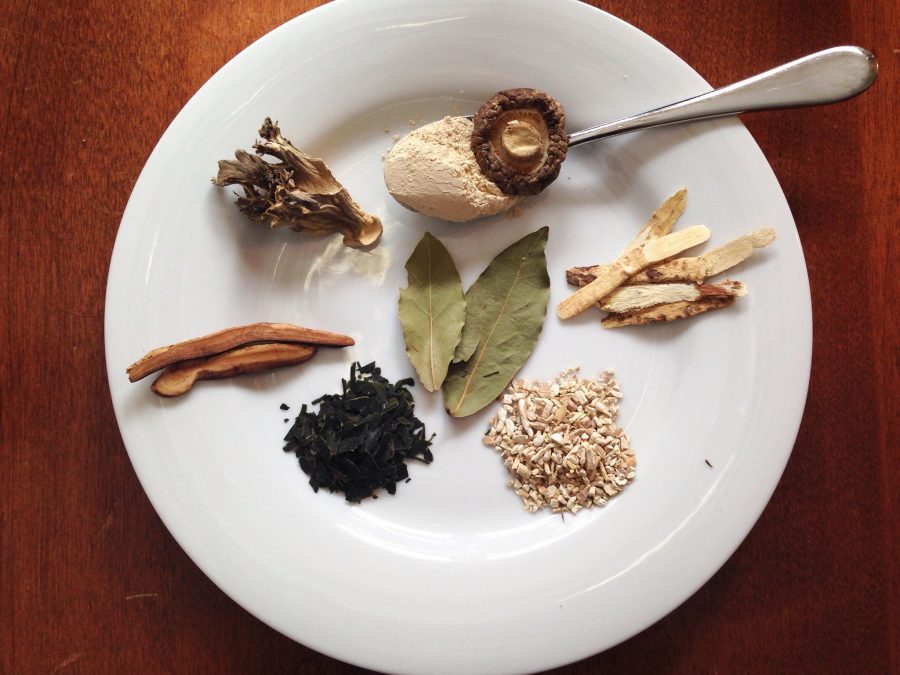
Mushroom Sources
- Check around your local community and farmers market for local growers and wildcrafters. Do research on the wildcrafter to ensure quality, identity, and sustainable practices. In my home state, I like New Hampshire Mushroom Company (cultivated fresh mushrooms) and Wichland Woods (cultivated fresh mushrooms and mushroom growing supplies). Boston-area Lana Camiel, host of Plant Love Radio, loves Mycoterra Farm (cultivated fresh mushrooms and grow kits).
- Mushroom Harvest: organic ready-to-consume mushroom powders and capsules that are combination of mycelium and/or activated fruiting bodies, www.mushroomharvest.com
- Mountain Rose Herbs: organic raw whole and powdered fruiting bodies (generally grown in China), mountainroseherbs.com
- Peaceful Harvest Mushrooms: ready-to-consume pre-cooked organic fruiting body with mycelium grown on millet, lion’s mane and cordyceps, peacefulharvestmushrooms.com
- Host Defense: organic ready-to-consume powders, capsules, blends, and liquid extracts made with mycelium grown on brown rice, hostdefense.com
- Real Mushrooms (Nammex): organic ready-to-consume fruiting body (grown in North America) hot water and alcohol extracted powders sold in powder and capsule, www.realmushrooms.com
My Favorite Mushroom Books & Resources
To learn about different mushrooms and their benefits…
- Christopher Hobbs’s Medicinal Mushrooms: The Essential Guide
- Greg Marley’s Mushrooms for Health (unfortunately out of print but still available as an e-book)
- Robert Rogers’s The Fungal Pharmacy
Beginner foraging guides focused on common and easy-to-identify popular edible and/or medicinal species include David L. Spahr’s Edible and Medicinal Mushrooms, Alexander Schwab’s Mushrooming with Confidence, and Gary Lincoff’s The Complete Mushroom Hunter
Learn More
Fungi with Benefits: Mushrooms for Food & Health Blog
Simmered Syrup Concentrate Blog + Video
Double Extraction Tincture Blog + Video
Nourishing Herb & Mushroom Broth Blog
Immune Hub + Immune Tea Recipes (including a deep immune chai with reishi)
Maria Noël Groves, RH (AHG), clinical herbalist, is the best-selling author of Body into Balance: An Herbal Guide to Holistic Self Care, and Grow Your Own Herbal Remedies. She runs Wintergreen Botanicals, nestled in the pine forests of New Hampshire. For herbal resources, the books, distance consults, and online classes, visit the main page of WintergreenBotanicals.com.
The statements made on this blog have not been evaluated by the FDA and are not intended to diagnose, prescribe, recommend, treat, cure, or offer medical advice. Please see your health care practitioner for help regarding choices and to avoid herb-drug interactions..
The article originally appeared in Herb Quarterly magazine in 2021.
